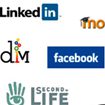
By Kimberley Kasper
June 2, 2011
When the phrase “social learning” gets thrown around, what people are referring to is a learning environment that incorporates social functionality such as blogs, RSS feeds, and video to create an engaging and easily accessible online sharing community. Such a system encourages learning in context, in the midst of a community of learners, rather than in isolation. It can also enable people to collaborate with others in the creation and discussion of new ideas. This increases engagement and use of online learning content, and enables organizations to capture emerging best practices and new ideas as well as refinements to known best practices.
The interplay between an organization’s Learning Management Systems (LMS) and its social learning platform can vary greatly, depending on company size. Large organizations tend to have enterprise social platforms already in place for their workforce, into which they feed LMS content such as course links, curriculum or virtual classroom registration. For small and mid-sized businesses, the LMS often pulls double duty as both a social platform for communication and collaboration-provided that the LMS features the needed social functionality-and as a typical LMS. Some smaller businesses even use an LMS as a public Web portal, further streamlining the number of platforms and technologies into one value-added solution.
Cricket Communications, the nation’s sixth largest wireless provider, provides a clear example of using an LMS to its full social advantage. The company leveraged its learning management system as the platform for Cricket University, its leadership development program. Employees can enroll in leadership courses and use self-assessment tools, leadership videos, RSS feeds and more.
The company’s best managers share their insights in video interviews, which are available on the leadership home page and the company intranet. An internal social networking site, MyCricketNation, promotes leadership discussions and hosts a blog on leadership written by the chief executive officer.
Vi, which operates retirement communities across the country under the Classic Residence brand, used its LMS to create an internal university named E-Campus. While Vi continues to leverage a multi-channel delivery strategy for training-including in-class instruction and webinars - the organization heavily leverages E-Campus to deliver compliance, leadership, remedial skills, and language and professional education courses in 21 locations.
To encourage greater employee engagement in online learning, Vi took the LMS’ customizable platform a step further by creating nine custom “learning center” micro-sites within E-Campus. The goal was to create greater relevance in training and communications throughout the organization. These learning centers not only contain the library of courses and knowledge for each department, but they also serve as a social tool for each of the departments. For instance, Vi’s sales organization hosts classes on their site, but they also leverage this site to post best practices through a blog and to monitor trends in the real estate and senior housing industries. Vi’s Medicare Compliance Team uses their site to provide regulatory updates and Medicare resource tools.
Because each function’s community manager has the ability to customize their site - adding resources, materials, photos, and content-Vi managers are highly engaged and take ownership of learning. As a result, the company reduced its learning costs by 28 percent while improving nurse compliance course completion by 12 percent and increasing customer satisfaction by 5.5 percent.
Organizations are experiencing an inflection point in how people learn, create and share in the workplace. As social learning and collaboration advance, it’s important to remember that organizations still need LMS solutions to satisfy complex regulatory and compliance reporting requirements in addition to course delivery and tracking. For organizations that don’t already have a large social platform in place, a configurable LMS with social functionality can play a powerful role.







